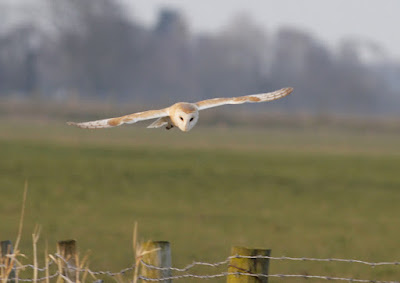Yesterday’s snow lasted a couple of hours here on the coast. Thank goodness that by late afternoon there was no sign of the white stuff. Today was Lazy Saturday except for another visit to the feeding station in the hills beyond Garstang where I expected to see a good amount of lying snow. But apart from a smattering on the higher fells there was little sign of Friday’s several centimetres. Maybe the snowfall had cleared out the birds because the feeding station was pretty quiet apart from the customary Chaffinches and Goldfinches.
With luck we’ll fit in a ringing session later in the week and catch up with a few Siskins. Via Yahoo “vismig” messaging it appears that February saw good numbers of Siskins heading north in both The Netherlands and Belgium, with some record counts during the last week.
In the meantime I drove back via Pilling Moss and stopped to view a field with approximately 450 each of both Fieldfares and Starlings and just a couple of wagtails. The Fieldfares appearing now are on the move north and have not wintered around here in any large numbers. The status of the Starlings is more difficult to judge but almost certainly many of those are not British birds but are on their way back north beyond these shores.
The field holding these birds is very soggy from months of rain, making it easy for both species to delve into the soft surface. The other attraction is the large number of molehills where the turned soil has exposed invertebrates and worms.
Fieldfare
Fieldfare
Like their cousins the Blackbird and the Song Thrush the Fieldfare searches for food using its acute hearing to locate food below the surface.
Fieldfare
The noise and activity of a thousand birds attracted first a Sparrowhawk and then a Buzzard. The Sparrowhawk had no luck and so flew off to try elsewhere. The Buzzard scattered all the feeding birds before landing on a line of fencing. But the average Buzzard is too lazy to chase fast flying birds like Fieldfares and Starlings, much better to sit and wait for a passing meal.
Starlings and Fieldfares
Buzzard
Buzzard
After a while the Buzzard flew into the field and began to delve into the soft soil and search the ground for easy pickings of earthworms and the like. By now the Starlings and Fieldfares had settled back into their own routine and while they gave the Buzzard elbow room, none of them took great exception to the presence of a harmless Buzzard.
Alas the Buzzard was too far back in the field for a photograph so I headed home for a lazy Saturday evening.
Linking today with Run A Round Ranch, Stewart's World Bird Wednesday and Anni's blog.
Linking today with Run A Round Ranch, Stewart's World Bird Wednesday and Anni's blog.










































































